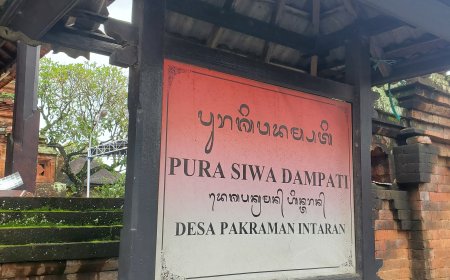Dalem Solo Temple: a cultural heritage site of the Sedang traditional village.
Dalem Solo temple, a sacred place that has evolved into a cultural heritage site in the traditional village of Sedang, is an exceptional example of Indonesia's cultural richness. With its magnificent ancient architectural structures and rich history, Pura Dalem Solo is not just a place of worship for Hindus; it also encapsulates a wealth of history and profound heritage for the local community. It stands as an authentic Balinese cultural treasure.

The temple, as a sacred structure, has been deeply rooted in the life of the community since ancient times. They are not only places of worship but also spiritual, social, and artistic spaces that influence the daily lives of those residing nearby. Over time, many of these temples have evolved beyond being mere places of worship; they have become invaluable cultural heritage sites. One such example is the Dalem Solo Temple.

Front view of the Dalem Solo Temple (source: editorial collection)
The Dalem Solo Temple is located in the village of Sedang, Abiansemal, Badung, approximately 11 km from Denpasar. This temple is primarily used for worship by the local community of Sedang. However, as time has passed, the Dalem Solo Temple has become more than just a place of worship for Hindu devotees. It has transformed into a cultural heritage site under the supervision of the Bali Cultural Heritage Preservation Office. Although the precise history of the temple's existence is still being uncovered, it has been mentioned in the Tattwa Catur Bhumi manuscript.
In this manuscript, it is mentioned that one of the descendants of the Majapahit Kingdom, bearing the title Ida Ratu Sakti, journeyed to the island of Bali. Guided by the instructions received during his meditation, many sacred places in Bali were used as sites for meditation. In short, Ida Ratu Sakti arrived in Bali with his followers and established a palace called 'Puri Dalem Sala' as his residence. Puri Dalem Sala is strongly believed to be the former name of the Dalem Solo Temple. However, over time, its name evolved into Pura Dalem Solo, which is also related to the Dalem Solo lineage being asked to rule Bali at that time.

Form of the Prasada Building (Source: Editorial Collection)
The architecture of the temple includes some elements dating back to the Majapahit era, making it a site with ancient structures. One of these elements is the Prasada building, an architectural construction known for its stone composition, which is a common feature in the temple structures found on the island of Java. In the Dalem Solo Temple, Prasada is constructed using brick material. Prasada, as a sacred structure in Hinduism, is considered a holy place to honor ancestors or rulers who have passed away and undergone a series of purification ceremonies.

Form of the Meru Building (Source: Editorial Collection)
There is also a Meru with a tumpeng roof that adds to the collection of ancient buildings within the temple grounds. This Meru structure features a five-tiered tumpeng roof made of ijuk (black palm fiber), supported by a wooden framework with four support pillars. Additionally, there are seated figurines and several sacred figurines believed to date back to the 18th century.
The Dalem Solo Temple is renowned for its Sang Hyang Jaran dance tradition, performed every fifth sasih (Balinese month). This dance is strongly associated with Ida Ratu Sakti. The Sang Hyang Jaran dance is not merely a mass entertainment; it is a sacred dance performed as part of a ceremony to ward off epidemics affecting a village or region. During the performance, the dancers are often believed to be trance and in this state, they dance, sometimes even on burning coals, before moving through the village to drive away the disease. Typically, these performances take place at night and continue until midnight.





























































